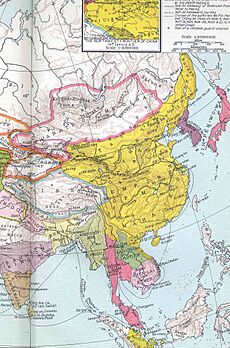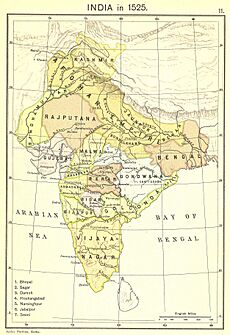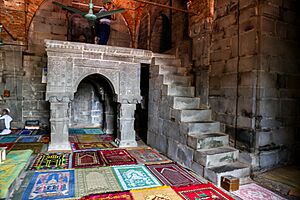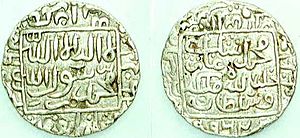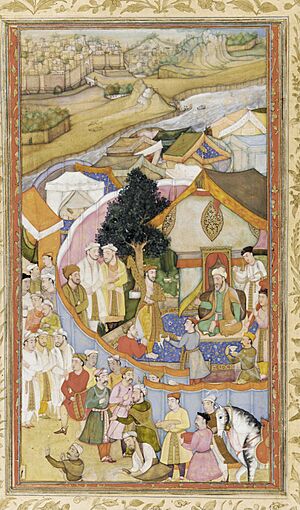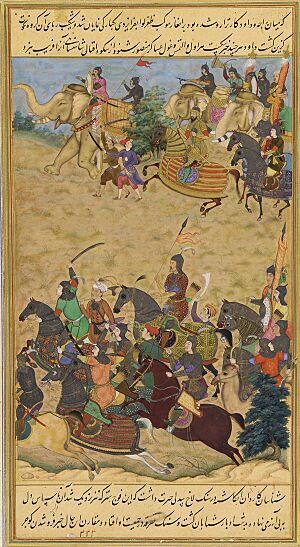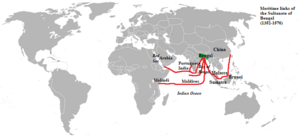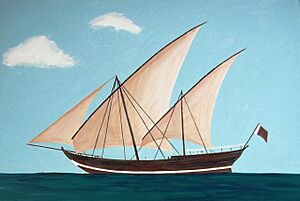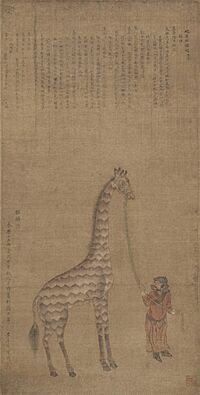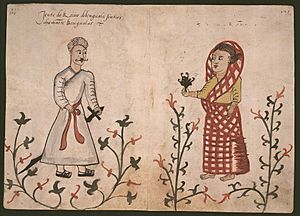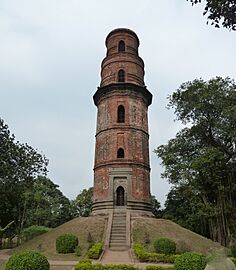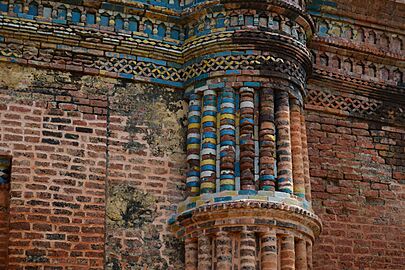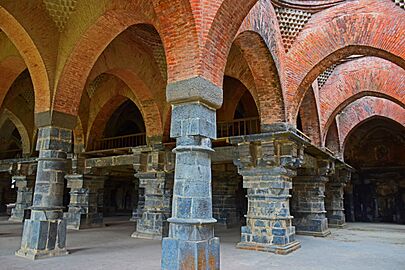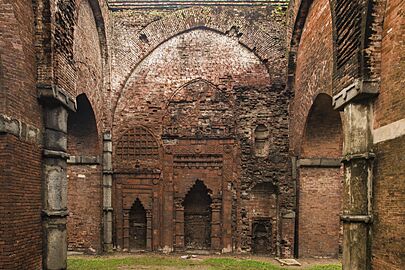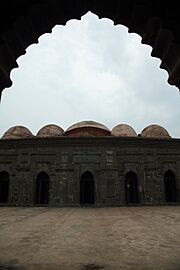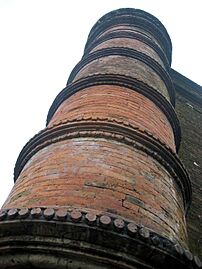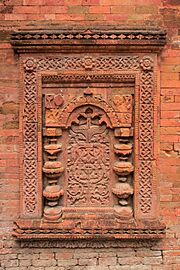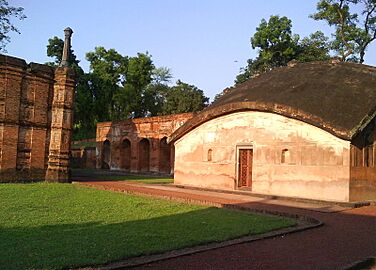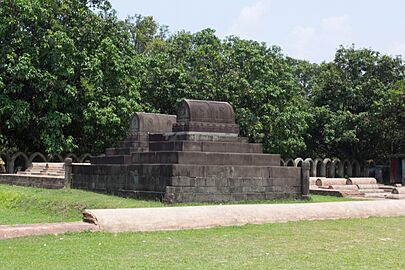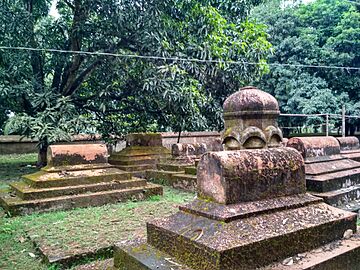Bengal Sultanate facts for kids
Quick facts for kids
Sultanate of Bengal
|
|||||||||||||||||||||||
|---|---|---|---|---|---|---|---|---|---|---|---|---|---|---|---|---|---|---|---|---|---|---|---|
| 1352–1539 1554–1576 |
|||||||||||||||||||||||
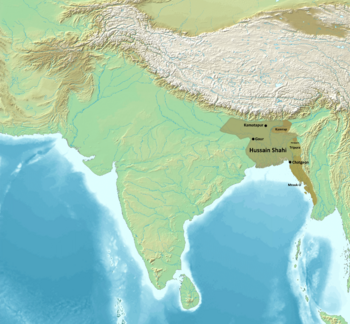
Extent of the Sultanate of Bengal under the Hussain Shahi dynasty.
|
|||||||||||||||||||||||
| Status | Sultanate | ||||||||||||||||||||||
| Capital | Pandua (1352–1390) Sonargaon (1390–1466) Gaur (1466–1565) Tanda (1565–1576) |
||||||||||||||||||||||
| Common languages | Bengali (official) Persian (official) Arabic (religious) |
||||||||||||||||||||||
| Religion | Sunni Islam (official) Hinduism Buddhism |
||||||||||||||||||||||
| Government | Absolute monarchy | ||||||||||||||||||||||
| Sultan | |||||||||||||||||||||||
|
• 1342–1358 (first)
|
Shamsuddin Ilyas Shah | ||||||||||||||||||||||
|
• 1572–1576 (last)
|
Daud Khan Karrani | ||||||||||||||||||||||
| History | |||||||||||||||||||||||
|
• Unification
|
1352 | ||||||||||||||||||||||
|
• Independence from Delhi
|
1353–1359 | ||||||||||||||||||||||
|
• Raja Ganesha's rebellion
|
1414 | ||||||||||||||||||||||
|
• Bengal–Jaunpur War
|
1415–1420 | ||||||||||||||||||||||
|
• Reconquest of Arakan
|
1429–1430 | ||||||||||||||||||||||
|
• Conquest of Chittagong
|
1512–1516 | ||||||||||||||||||||||
|
• Suri invasion
|
1539 | ||||||||||||||||||||||
|
• Restoration
|
1554 | ||||||||||||||||||||||
|
• Mughal invasion
|
1572–1576 | ||||||||||||||||||||||
|
• Battle of Raj Mahal
|
12 July 1576 | ||||||||||||||||||||||
| Currency | Taka | ||||||||||||||||||||||
|
|||||||||||||||||||||||
| Today part of | Bangladesh India Myanmar |
||||||||||||||||||||||
The Bengal Sultanate was a powerful kingdom in the Bengal region of South Asia. It existed from the 14th to the 16th century. This sultanate was the main power in the Ganges-Brahmaputra Delta. It had many cities where coins were made. The Bengal Sultanate also had smaller kingdoms that paid tribute to it. These included parts of Odisha, Arakan, and Tripura.
This kingdom controlled large areas of eastern South Asia. It was strongest under the Hussain Shahi dynasty. Its armies reached Nepal in the north and Assam in the east. It was known as a rich trading nation and one of Asia's strongest states. The kingdom started to decline after an invasion by the Suri Empire. Later, the Mughal Empire conquered it.
The Bengal Sultanate was a Muslim kingdom. Its leaders and important people came from different backgrounds. These included Bengalis, Persians, Afghans, and Abyssinians. The most famous ruling families were the Ilyas Shahi, House of Ganesha, and Hussain Shahi. The kingdom was known for being open to different religions. Muslims and non-Muslims lived together peacefully.
While Persian was the main official language, Bengali was also used in the royal court. Cities of the Bengal Sultanate were called "Mint Towns." This is where the taka currency was made. These cities had grand buildings. Around 1500, the capital city of Gaur was the fifth largest city in the world. Other important cities included Pandua, Sonargaon, the Mosque City of Bagerhat, and the port of Chittagong. The Bengal Sultanate traded with countries in Asia, Africa, and Europe by sea and land. It was a major trading center that attracted people from all over the world. Bengali ships traded in places like Malacca, China, and the Maldives.
Visitors from Europe and China described the Bengal Sultanate as a very rich kingdom. People said Bengal was the "richest country to trade with" because it had so many goods. The Bengal Sultanate also left behind amazing buildings. These buildings mixed foreign styles with a unique Bengali design. It was the largest and most respected Muslim kingdom in the history of Bengal.
Contents
History of the Bengal Sultanate
How the Sultanate Began (13th and 14th Centuries)
Bengal slowly became part of the Delhi Sultanate in the 1200s. This started when a general named Bakhtiyar conquered Gauda. After his death, Bengal was ruled by different governors. These governors often tried to rule independently from Delhi.
Some strong rulers emerged, like Shamsuddin Firoz Shah. He conquered Sylhet and set up a good government in eastern Bengal. In 1325, the Delhi Sultan divided Bengal into three areas. But even this plan failed. By 1338, each area had its own independent ruler.
One of these rulers was Shamsuddin Ilyas Shah (Ilyas Shah). He defeated the other rulers and took control of all of Bengal by 1352.
Early Years of the Sultanate (14th and 15th Centuries)
Ilyas Shah made Pandua his capital. He united the lands around the Ganges, Brahmaputra, and Meghna Rivers. He fought wars and raided other kingdoms. He even led the first Muslim army into Nepal and brought back treasures. His kingdom stretched from Assam in the east to Varanasi in the west.
In 1353, the Delhi Sultan Firuz Shah Tughluq attacked Ilyas Shah. Bengal had to pay tribute to Delhi. But Ilyas Shah still kept strong control over Bengal.
Ilyas Shah started the Ilyas Shahi dynasty. This family ruled Bengal for 150 years. His son, Sikandar Shah, defeated the Delhi Sultan in 1359. They signed a peace treaty, and Delhi recognized Bengal's independence. This peace lasted for two centuries.
Sikandar Shah ruled for 30 years. He built the Adina Mosque, a very large mosque. During this time, many Hindu landowners controlled farms. This sometimes caused problems with Muslim landowners.
Bengal became an important Islamic kingdom in the east. It was part of a chain of Islamic kingdoms from Spain to India. These kingdoms had people from many different backgrounds. Persian and Arabic were used alongside local languages. In Bengal, the Bengali language became important in the royal court.
The third Sultan, Ghiyasuddin Azam Shah, made Bengal famous abroad. He sent messages to Ming China, a tradition his successors continued. He also paid for buildings in Arabia. He even wrote letters and poems with the famous Persian poet Hafez. The Bengal Sultans showed respect to the Abbasid Caliphate in Cairo. Their coins often had the Caliph's name on them.
Ghiyasuddin Azam Shah held his court in Sonargaon and Pandua. Chinese visitors said Sonargaon was a big city with a busy river port. This port connected Bengal to China, Southeast Asia, and the Middle East. Sonargaon was also a center for religious learning and Persian writing.
New Rulers Emerge (15th Century)
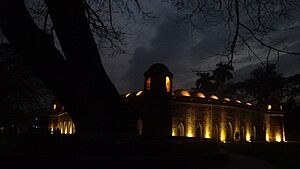
In the early 1400s, a powerful Hindu landowner named Raja Ganesha challenged the Ilyas Shahi rulers. He put his son, Jalaluddin Muhammad Shah, on the throne. His son had converted to Islam. Jalaluddin's rule was short but important. He helped an Arakanese king regain his kingdom. He also brought more Bengali styles into the kingdom's buildings and government. He even declared himself the Caliph, showing Bengal's independence. The Ilyas Shahi dynasty returned to power in 1432.
Nine kings ruled Bengal from Pandua for 100 years. They built palaces, forts, bridges, mosques, and tombs. A Chinese visitor, Ma Huan, described Pandua as a city with impressive walls and busy markets. It was known for exporting fine cloth and wine. High-quality paper was also made there.
Sultan Mahmud Shah of Bengal moved the capital from Pandua to Gaur in 1450. This might have been because nearby rivers changed their course.
Under Mahmud Shah, Bengal gained more control over the Sundarbans area. The governor of the Sundarbans, Khan Jahan Ali, built the city of Khalifatabad. Later, in the late 1480s, four rulers from the Abyssinian mercenary group took power. Problems between different Muslim groups sometimes affected the kingdom.
A Growing Empire (15th and 16th Centuries)
Alauddin Hussain Shah became the ruler of Bengal in 1494. He was the prime minister before. He started the Hussain Shahi dynasty, which was of Arab or Afghan origin. He brought an end to a time of trouble. Hussain Shah ruled until 1519, and his family ruled until 1538.
During the Hussain Shahi dynasty, both Muslims and Hindus worked in the government. This time is often seen as the "golden age" of the Bengal Sultanate. Bengal's land grew to include parts of Arakan, Orissa, Tripura, and Assam. Hussain Shah's army conquered large parts of Assam. He also brought back Bengali control over Chittagong and northern Arakan.
Hussain Shah made coins saying he was the "conqueror of Kamrupa, Kamata, Jajnagar and Orissa." He also expanded Bengal's land west into Bihar. The Sultan of Jaunpur sought safety in Bengal after being attacked by the Lodi dynasty of Delhi. The Delhi Sultan then attacked Bengal. But they signed a peace treaty and the Delhi Sultan left. Under Nasiruddin Nasrat Shah, the Sultanate took over the Mithila region in 1526.
After Vasco Da Gama arrived in India, Portuguese visitors often came to Bengal. Portuguese merchants lived in Gaur, the capital. They described Gaur as a very rich city, like Lisbon. It had a fort, a royal palace, mosques, and busy markets. The Sultan of Bengal allowed the Portuguese to set up a trading post in Chittagong. However, this trading post was later taken over by pirates who worked with the Arakanese against Bengal.
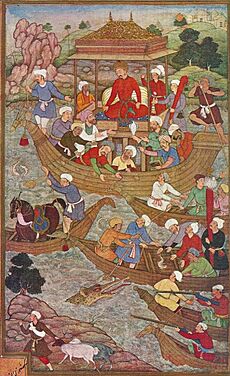
Decline of the Sultanate (16th Century)
Bengal slowly became part of the Mughal Empire. This began when the first Mughal ruler, Babur, defeated Bengal's forces in 1529. The second Mughal ruler, Humayun, took over Gaur, Bengal's capital. This happened during an invasion by Sher Shah Suri, who fought against both the Mughals and Bengal. Humayun later had to flee to Persia.
Sher Shah Suri conquered Bengal and created the Sur Empire. This empire was of Afghan origin. During this time, the Grand Trunk Road was improved. The Sur rulers appointed governors in Bengal. The third governor, Muhammad Khan Sur, declared independence after the death of Islam Shah Suri. Muhammad Khan brought back the Bengal Sultanate under the Muhammad Shahi dynasty, which was also Afghan.
The Karrani dynasty was the last ruling family of the sultanate. Sultan Sulaiman Khan Karrani moved the capital from Gaur to Tanda in 1565. He conquered large parts of Orissa. Under him, the Bengal Sultanate stretched from Koch Bihar in the north to Puri in the south. It went from the Son River in the west to the Brahmaputra River in the east.
The Mughals wanted to stop Bengal's expansion and take its riches. In 1575, the Mughal forces, led by Akbar, defeated the Bengal Sultanate's army at the Battle of Tukaroi. This led to a peace treaty. Mughal rule officially began after the Battle of Raj Mahal in 1576. Here, Akbar's forces defeated the last Sultan of Bengal, Daud Khan Karrani.
The Mughal province of Bengal Subah was created. However, the eastern delta region, called Bhati, remained outside Mughal control for a while. It was ruled by a group of twelve nobles from the former sultanate, known as the Baro Bhuyans. Their leader was Isa Khan. The Mughal government eventually took full control of all of Bengal in the early 1600s.
How the Sultanate Was Ruled
The Bengal Sultanate was an absolute monarchy, meaning the Sultan had all the power. It was influenced by Persian traditions. The system for collecting taxes used the Bengali language. The government hired both Muslims and Hindus, which showed religious tolerance. The Sultan also relied on the support of Islamic scholars.
The Sultanate was divided into smaller areas. These were further split into even smaller regions.
Mint Towns
Mint towns were royal and provincial capitals where taka coins were made. This made them important economic centers. As the kingdom grew, more mint towns appeared. Some of these towns included:
- Jannatabad (Lakhnauti)
- Muzzamabad (Sonargaon)
- Ghiyaspur (Mymensingh)
- Satgaon
- Firuzabad (Hazrat Pandua)
- Shahr-i-Naw (Hazrat Pandua)
- Fathabad (Faridpur)
- Chatgaon (Chittagong)
- Mahmudabad (Jessore and Nadia)
- Barbakaabad (Dinajpur)
- Muzaffarabad (Pandua)
- Muhammadabad
- Husaynabad (24 Parganas)
- Chandrabad (Murshidabad district)
- Nusratabad (Dinajpur district)
- Khalifatabad/Badarpur (Bagerhat district)
- Sharifabad (Birbhum district)
- Khwaspur Tandah (Malda district)
- Rotaspur (Bihar)
Vassal States
Vassal states were smaller kingdoms that paid tribute to the Sultan of Bengal. They were on the edges of the Sultanate. The Sultan did not directly control these areas for different reasons. Vassal states had Muslim, Hindu, and Buddhist rulers. Here are some important ones:
Arakan
In the southeast, Arakan was an important vassal. In 1430, the Bengal Sultanate helped restore the Arakanese king to his throne. Arakan paid tribute to Bengal for many years. Arakanese rulers copied Bengal's governing style. They used the title Shah and made coins with Arabic and Bengali writing. Over time, Arakan became independent and a strong coastal power.
Chandradwip
In southern Bengal, the island of Chandradwip had Hindu rulers. It was a vassal state until the Hussain Shahi dynasty formally took it over.
Pratapgarh
In the northeast, the ruler of the Pratapgarh Kingdom declared himself a Sultan. This angered Alauddin Husain Shah, who sent an army to defeat him. The ruler of Pratapgarh was defeated and agreed to pay tribute to Bengal. He also gave up his claims over Sylhet.
Tripura
In the east, Tripura was important to Bengal for its gold, silver, and other goods. Tripura had gold mines and trade routes to the Far East. In 1464, the Sultan of Bengal helped Ratna Manikya I become the king of Tripura. Tripura was a key vassal of Bengal.
Orissa
In the southwest, Orissa was important in Bengal's military history. The first Bengali Sultan, Shamsuddin Ilyas Shah, defeated the rulers of Orissa. He raided Jajpur and Cuttack and returned with treasures. During Alauddin Hussain Shah's rule, Orissa was a vassal state. Northern Orissa was directly ruled by Bengal.
Military Power
The Sultans had a well-organized army with cavalry (soldiers on horses), artillery (cannons), infantry (foot soldiers), and war elephants. They also had a navy. Because Bengal had many rivers, it was hard to use cavalry all year. Horses had to be brought from other countries, making cavalry the weakest part of the army.
Artillery was very important. A Portuguese historian said Bengal's army was strong because of its good cannons and guns. Foot soldiers, called paiks, were a vital part of the army. They used bows, arrows, and guns.
War elephants were also very important. They carried supplies and soldiers. In river-filled Bengal, elephants were useful, even if slow. The navy was essential for river travel. War boats played a big role in the country's politics. The head of the navy was in charge of building ships, transporting goods, hiring sailors, and patrolling rivers. However, the navy became weaker during the Hussain Shahi dynasty. The Sultans also built forts, some with temporary mud walls.
Wars with Delhi
In 1353, the Sultan of Delhi attacked Bengal. Bengal agreed to pay tribute. But in 1359, Delhi invaded again. They eventually signed a new treaty, and Delhi recognized Bengal's independence. Bengal also got help from allies in South India. In the 16th century, the Lodi dynasty of Delhi attacked Bengal again, but they later agreed to a peace treaty.
War with Jaunpur
The Jaunpur Sultanate attacked Bengal in the 15th century. With help from Ming China and the Timurid ruler of Herat, Bengal fought off the invasion.
Campaigns in Arakan and Assam
Bengal often invaded Arakan and the Brahmaputra Valley. In 1430, the Bengal Sultanate defeated Burmese forces in Arakan. They put Min Saw Mon back on the throne as a vassal king. But later, Arakan and Bengal fought over control of Chittagong. Arakan became an independent coastal power. Under Alauddin Husain Shah, Bengal regained control of Chittagong and northern Arakan. However, the Arakanese kept fighting for Chittagong, often with the help of Portuguese pirates.
During Husain Shah's rule, Bengal's control over Assam was at its strongest. The Bengali army overthrew the Hindu Kamata Kingdom in 1498. This extended the Sultanate's reach far into Assam. However, local leaders in Assam later took back control.
Sher Shah Suri's Invasion
Bengal was conquered by Sher Shah Suri and became part of the Suri Empire. The Mughal Empire also occupied parts of Bengal during this time. Both the Mughals and Bengal were defeated by Suri forces. Bengal later regained its independence when Suri governors rebelled and brought back the sultanate.
Wars with the Mughals
The first Mughal emperor, Babur, turned his attention to Bengal after a battle in 1526. In 1529, Bengal signed a peace treaty with Babur. During Sher Shah Suri's invasion, the second Mughal emperor, Humayun, occupied Gaur. The third Mughal emperor, Akbar, started a war against Bengal in 1575. Akbar finally defeated the last Sultan of Bengal at the Battle of Raj Mahal in 1576.
Economy and Trade
The Bengal Sultanate's economy was similar to the earlier Delhi Sultanate. It had mint towns, paid government workers, and a system of land ownership. Making silver coins with the Sultan's name showed Bengal's independence. Bengal was very good at using only silver coins, more so than other kingdoms. Silver came from old kingdoms' reserves, tribute payments from smaller kingdoms, and from military campaigns.
Bengal's economy grew strong in the early 15th century. This was partly because it no longer had to pay tribute to Delhi. A Chinese visitor, Ma Huan, wrote about Bengal's busy shipbuilding industry. This showed that Bengal had a lot of trade by sea. The production of muslin cloth and silk grew. Ma Huan listed many items Bengal exported to China. Bengali ships traded alongside Chinese ships until China stopped trading in the Indian Ocean in the mid-1400s. European travelers also wrote about many rich Bengali merchants and shipowners in Malacca. Historians think Bengal's ports might have been places where goods were imported and then sent to China.
Bengal had a strong tradition of building ships for river travel. This is clear from the Sultanate's naval battles in the Ganges delta. Trade between Bengal and the Maldives, involving rice and cowry shells, likely used Arab-style baghlah ships. Chinese reports say Bengali ships were common in Southeast Asian waters. One Bengali ship was so large it could carry three different groups of envoys to China. Bengali ships were the biggest in Southeast Asia during those decades.
All large business deals used silver taka coins. Smaller purchases used shell currency. One silver coin was worth 10,250 cowry shells. Bengal imported many cowry shells from the Maldives. Because the land was fertile, there was plenty of food. This included bananas, jackfruits, sugarcane, and honey. Local crops were rice and sesame. Vegetables included ginger, onions, and garlic. There were four types of wines. Bengali streets had many places to eat, drink, and bathe. Betel nut was offered to guests.
The population included royalty, nobles, locals, and foreigners. Many rich people built ships and traveled abroad for trade. Many others were farmers. Punishments for breaking the law included being sent out of the kingdom or being flogged with bamboo.
Europeans and Chinese called Bengal "the richest country to trade with." Bengal was a major trading hub in eastern India. Like the Gujarat Sultanate in the west, Bengal gained wealth from sea trade. Merchants from all over the world traded in the Bay of Bengal. Bengal was famous for exporting cotton textiles. Marco Polo noted Bengal's importance in the textile trade. In 1569, a Venetian explorer wrote about how merchants from Burma traded silver and gold with Bengalis. Land trade routes, like the Grand Trunk Road, connected Bengal to northern India, Central Asia, and the Middle East.
Foreign Relations
The Bengal Sultanate had strong relationships with other countries. Records show that Bengal exchanged messages with countries in China, Europe, Africa, Central Asia, South Asia, and Southeast Asia. Diplomatic friends helped Bengal fight off invasions. For example, the Timurid ruler of Herat and the Ming emperor of China helped end the Bengal Sultanate–Jaunpur Sultanate War.
Bengal was also active in regional diplomacy. For instance, a Bengali ship carrying Bengal's envoys to China also carried envoys from Brunei and Aceh. Bengal allowed envoys from Portuguese India to set up trading posts on its coast. Other European visitors included Niccolo De Conti and Ludovico di Varthema.
In the Islamic world, the Sultanate showed respect to the Abbasid Caliphate in Cairo. The Abbasid caliph was seen as the leader of Sunni Islam. For the Bengali Sultans, this connection gave them more authority among Muslim religious leaders. For example, the Sultan Jalaluddin Muhammad Shah received recognition from the Caliph, which made his rule stronger. Many coins made by the Bengal Sultanate had the names of both the Bengali Sultans and the Abbasid Caliphs.
Sultan Ghiyasuddin Azam Shah paid for the building of Islamic schools in the holy cities of Makkah and Madinah. These schools were called the Ghiyasia Madrasa and Banjaliah Madrasa. Other Bengali Sultans also supported schools in the Hejaz region.
From Africa, the Sultan Ashraf Barsbay of Egypt sent the Bengali Sultan a special robe and a letter of recognition. There are also records of envoys from the East African city-state of Malindi visiting the Bengali court. These envoys brought giraffes as gifts, which Chinese envoys in Bengal also noticed. In Central Asia, Sultan Jalaluddin Muhammad Shah had contact with Sultan Shahrukh Mirza of the Timurid Empire. In Southeast Asia, European accounts mention many Bengali merchants in the Malacca Sultanate. These merchants were rich shipowners.
Within South Asia, Bengal had both difficult and peaceful relationships with the Delhi Sultanate and the Jaunpur Sultanate. The Delhi Sultanate first received tribute from Bengal between 1353 and 1359. This stopped after a war and peace treaty in 1359. Sultan Ghiyasuddin Azam sent envoys to the neighboring Jaunpur Sultanate. He sent elephants as gifts. The two sultanates fought a war between 1415 and 1420. After the war, there was a long period of peace. In 1494, the Jaunpuri Sultan was given safety in Bengal after being defeated by the Lodi dynasty of Delhi.
On the coast of the Bay of Bengal, the Bengal Sultanate became powerful in controlling Arakan. Min Saw Mon, a deposed Arakanese king, fled to Bengal after a Burmese invasion. With help from Bengali forces, he regained control of his country. The restored Arakanese kingdom became a vassal state of Bengal. A war with Arakan in 1459 led to the defeat of Bengali Sultan Rukunuddin Barbak Shah. The Arakanese later formed an alliance with Portuguese traders in Chittagong against Bengal. Even after gaining independence, Arakanese kings continued to copy Bengali Sultans in their clothing, coins, titles, and government methods. Bengali Muslim influence on Arakan lasted for 350 years. In the Indian Ocean, Bengal traded with the Maldives, exchanging rice for cowry shells.
Historians have studied Bengal's relationship with Ming China in the early 15th century. This relationship was also mentioned by Indian leader Jawaharlal Nehru. Political ties between China and India had stopped after Buddhism declined in India. But in the 15th century, the Bengal Sultanate restarted these ties with regular contact. Sultan Ghiyasuddin Azam Shah began sending envoys to the Ming dynasty in 1405, 1408, and 1409. Emperor Yongle of China sent ambassadors to Bengal between 1405 and 1433, including members of the Treasure voyages fleet led by Admiral Zheng He. In 1414, Sultan Shihabuddin Bayazid Shah sent a giraffe from East Africa as a gift to the Chinese emperor. China also helped end the Bengal-Jaunpur War after Sultan Jalaluddin Muhammad Shah asked for help. Ming China thought Bengal was "rich and civilized" and one of the strongest countries in Asia during the 15th century.
Culture and Society
The Bengali language was the most spoken language. Persian was used for government and business. Men wore white shirts, colorful cotton clothes, turbans, and leather shoes. Women wore cotton saris. Upper-class women wore gold jewelry. There were different types of skilled workers, doctors, and fortune tellers. Musicians would play music outside rich houses in the morning and be rewarded with food and money. Some men even performed with chained tigers. Hindus, a minority, did not eat beef. Streets and markets had bathing areas, places to eat and drink, and dessert shops. Betel nut was offered to guests. The population included royalty, nobles, locals, and people from other countries. Many rich people built ships and traveled abroad for trade. Many others were farmers.
Bengal welcomed settlers from North India, the Middle East, and Central Asia. These included Turks, Afghans, Persians, and Arabs. Persians were an important group, working as teachers, lawyers, scholars, and religious leaders. Mercenaries (soldiers for hire) were brought in for military and political jobs. One group of mercenaries was from Abyssinia (modern-day Ethiopia).
Arts and Buildings
Literature and Painting
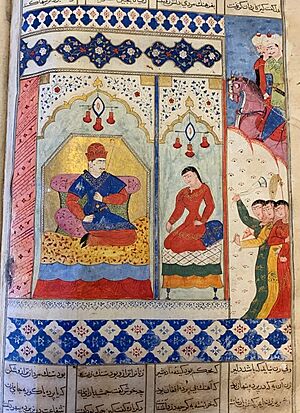
Muslim poets started writing in Bengali by the 15th century. By the early 1500s, Bengali literature based on Sufism and Islamic ideas became popular. Bengali Muslim mystic writing was very unique in Islamic India.
And with the three washers [cups of wine], this dispute is going on.
All the parrots [poets] of India have fallen into a sugar shattering situation (become excited)
That this Persian candy [ode], to Bangalah [Bengal] is going on.
-A poem written by Hafez and Sultan Ghiyasuddin Azam Shah in the 14th century.
Since Persian was an official language, many Persian scholars, lawyers, teachers, and religious leaders came to Bengal. It was the preferred language of the nobles and Sufis. Thousands of Persian books were published in Bengal. Sultan Ghiyasuddin Azam Shah's time was called the "golden age of Persian literature in Bengal." He even wrote letters to the famous Persian poet Hafez.
Paintings in old books show the fashion and buildings of the Bengal Sultanate. Persian books with paintings are a key part of Bengal's art. A famous example is Sultan Nasrat Shah's copy of Nizami's Iskandar Nama. This book, made between 1519 and 1538, has epic poems about the conquests of Alexander the Great.
In the 15th century, a court scholar named Nur Qutb Alam started a new style of Bengali Muslim poetry. Poems were written half in Persian and half in everyday Bengali. Islamic figures began to be mentioned instead of Hindu gods in Bengali texts. Romantic poems were written by Shah Muhammad Sagir and others. This style used Arabic and Persian words in Bengali to tell Muslim stories. Epic poems included Nabibangsha and Janganama. Bengali Muslim writers translated many Arabic and Persian works, like the Thousand and One Nights.
Hindu poets from this time included Maladhar Basu and Vijay Gupta.
Architecture and Buildings
Most of the Bengal Sultanate's cities and remaining buildings are in Bangladesh. These buildings are studied in a book called Sultans and Mosques. The Indian state of West Bengal has two former capitals, Gaur and Pandua, with old watchtowers, walls, and tombs. The oldest mosque in Assam, India, is from the Bengal Sultanate. A 15th-century mosque from this time is found in ruins in Myanmar.
City Buildings
Cities in the Bengal Sultanate had grand medieval buildings, especially in the capitals of Gaur and Pandua. In 1500, Gaur was the fifth-largest city in the world. It had about 200,000 people. A Portuguese historian described houses in Gaur as one-story with decorated floors, courtyards, and gardens. The city had a fort, a royal palace, watchtowers, canals, bridges, large gates, and a city wall. The royal palace had three parts: the court, the Sultan's living area, and the harem. A high wall and a moat surrounded the palace.
The city of Pandua grew from a small village into a military base. It had imperial mosques and tombs. City buildings in the Bengal Sultanate mixed Arab, Bengali, Persian, Indo-Turkish, and Byzantine styles. Paintings from the Iskandar Nama book show what houses looked like. Unique Bengal roofs started appearing in the 15th century. These roofs were later copied in the Mughal Empire and other Indian kingdoms.
- City buildings in the Bengal Sultanate
Mosque Buildings
Mosques of the Bengal Sultanate have common features. These include pointed arches, many prayer niches (mihrabs), corner towers, and decorations made of terracotta and stone. The art of the mihrab is very detailed and unique to Bengal's mosques. Mosques were either rectangular with many domes or square with one dome. The large number of mosques built shows how quickly people in the area converted to Islam.
Between 1450 and 1550, many mosques were built. These mosques were found everywhere, from small to medium sizes, and were used for daily prayers. Ponds were often next to mosques. Arabic writings in the mosques often included the name of the person who paid for or built them. The buildings were made of brick or stone. Brick mosques with terracotta decorations were grand structures. They were often gifts from rich people.
Mosques were built all over the Bengal Sultanate. The most mosques from this time are found in northern Bangladesh and Indian West Bengal. A mosque city grew near the Sundarbans forest. This was thanks to Governor Khan Jahan Ali. In 1985, UNESCO made this city a World Heritage Site. In central areas, the Pathrail Mosque is one of the best-preserved buildings from the Sultanate era. In the northeast, the Shankarpasha Shahi Masjid in Sylhet is also well-preserved. In Assam, India, the Panbari Mosque was built during Sultan Alauddin Hussain Shah's rule. Other mosques are found in coastal West Bengal and parts of Bihar. In the southeast, the Santikan Mosque (built in the 1430s) is in ruins in Myanmar.
Imperial mosques had a special throne for the Sultan, called Badshah-e-Takht (King's Throne). Sultans sat on this raised throne to address their people. They also used these mosques to make decisions and handle government affairs. Mosques served as royal courts. Sultans traveled from town to town and held court in mosques with a Badshah-e-Takht. The throne in Kusumba Mosque is beautifully decorated. The Adina Mosque has one of the largest royal galleries in the region.
- Mosque buildings in the Bengal Sultanate
Tomb Buildings
Tombs from the Bengal Sultanate are important examples of its architecture. Early tombs were like Iranian models. They often included mihrabs and arches similar to those in Adina Mosque. For example, the tomb of Sultan Ghiyasuddin Azam Shah in Sonargaon looks like the Adina Mosque built by his father. A unique Islamic tomb style developed with the Eklakhi Mausoleum, which is the royal tomb of Sultan Jalaluddin Muhammad Shah. Other tombs, like the Tomb of Fateh Khan in Gaur, had a Bengal roof.
- Tomb buildings in the Bengal Sultanate
Legacy
The buildings of the Bengal Sultanate have influenced modern architecture in Bangladesh. For example, the Baitur Rauf Mosque, which won an award in 2016, was inspired by the Sultanate era.
List of Dynasties
- Ilyas Shahi dynasty (1342–1414)
| Name | Reign | Notes |
|---|---|---|
| Shamsuddin Ilyas Shah | 1342–1358 | Became the first sole ruler of all Bengal. |
| Sikandar Shah | 1358–1390 | Killed by his son, Ghiyasuddin Azam Shah. |
| Ghiyasuddin Azam Shah | 1390–1411 | |
| Saifuddin Hamza Shah | 1411–1413 | |
| Muhammad Shah bin Hamza Shah | 1413 | Killed by his father's slave on orders from Raja Ganesha. |
| Shihabuddin Bayazid Shah | 1413–1414 | Killed by Raja Ganesha. |
| Alauddin Firuz Shah I | 1414 | Son of Shihabuddin Bayazid Shah. Killed by Raja Ganesha. |
- House of Raja Ganesha (1414–1435)
| Name | Reign | Notes |
|---|---|---|
| Raja Ganesha | 1414–1415 | |
| Jalaluddin Muhammad Shah | 1415–1416 | Son of Raja Ganesha, converted to Islam. |
| Raja Ganesha | 1416–1418 | Second time ruling. |
| Jalaluddin Muhammad Shah | 1418–1433 | Second time ruling. |
| Shamsuddin Ahmad Shah | 1433–1435 |
- Restored Ilyas Shahi dynasty (1435–1487)
| Name | Reign | Notes |
|---|---|---|
| Nasiruddin Mahmud Shah I | 1435–1459 | |
| Rukunuddin Barbak Shah | 1459–1474 | |
| Shamsuddin Yusuf Shah | 1474–1481 | |
| Sikandar Shah II | 1481 | |
| Jalaluddin Fateh Shah | 1481–1487 |
- Habshi rule (1487–1494)
| Name | Reign | Notes |
|---|---|---|
| Shahzada Barbak | 1487 | |
| Saifuddin Firuz Shah | 1487–1489 | |
| Mahmud Shah II | 1489–1490 | |
| Shamsuddin Muzaffar Shah | 1490–1494 |
- Hussain Shahi dynasty (1494–1538)
| Name | Reign | Notes |
|---|---|---|
| Alauddin Hussain Shah | 1494–1518 | |
| Nasiruddin Nasrat Shah | 1518–1533 | |
| Alauddin Firuz Shah II | 1533 | |
| Ghiyasuddin Mahmud Shah | 1533–1538 |
- Governors under Suri rule (1539–1554)
| Name | Reign | Notes |
|---|---|---|
| Khidr Khan | 1539–1541 | Declared independence in 1541 and was replaced. |
| Qazi Fazilat | 1541–1545 | |
| Muhammad Khan Sur | 1545–1554 | Declared independence after Islam Shah Suri died. |
- Muhammad Shahi dynasty (1554–1564)
| Name | Reign | Notes |
|---|---|---|
| Muhammad Khan Sur | 1554–1555 | Declared independence and called himself Shamsuddin Muhammad Shah. |
| Ghiyasuddin Bahadur Shah II | 1555–1561 | |
| Ghiyasuddin Jalal Shah | 1561–1563 | |
| Ghiyasuddin Bahadur Shah III | 1563–1564 |
- Karrani dynasty (1564–1576)
| Name | Reign | Notes |
|---|---|---|
| Taj Khan Karrani | 1564–1566 | |
| Sulaiman Khan Karrani | 1566–1572 | Defeated by the Mughal forces. |
| Bayazid Khan Karrani | 1572 | |
| Daud Khan Karrani | 1572–1576 |
Family trees
Ilyas Shahi Dynasty (1342–1414)
| Ilyas Shahi Dynasty | |||||||||||||||||||||||||||||||||||||||||||||||||||||||||||||||||||||||||||||||||||||||||||||||||||||||||||||||||||||||||||||||||||||||||||||||||||||||||||||||||||||||||||||||||||||||||||||||||||||||||||||||||||||||||||||||||||
|---|---|---|---|---|---|---|---|---|---|---|---|---|---|---|---|---|---|---|---|---|---|---|---|---|---|---|---|---|---|---|---|---|---|---|---|---|---|---|---|---|---|---|---|---|---|---|---|---|---|---|---|---|---|---|---|---|---|---|---|---|---|---|---|---|---|---|---|---|---|---|---|---|---|---|---|---|---|---|---|---|---|---|---|---|---|---|---|---|---|---|---|---|---|---|---|---|---|---|---|---|---|---|---|---|---|---|---|---|---|---|---|---|---|---|---|---|---|---|---|---|---|---|---|---|---|---|---|---|---|---|---|---|---|---|---|---|---|---|---|---|---|---|---|---|---|---|---|---|---|---|---|---|---|---|---|---|---|---|---|---|---|---|---|---|---|---|---|---|---|---|---|---|---|---|---|---|---|---|---|---|---|---|---|---|---|---|---|---|---|---|---|---|---|---|---|---|---|---|---|---|---|---|---|---|---|---|---|---|---|---|---|---|---|---|---|---|---|---|---|---|---|---|---|---|---|---|---|
|
|||||||||||||||||||||||||||||||||||||||||||||||||||||||||||||||||||||||||||||||||||||||||||||||||||||||||||||||||||||||||||||||||||||||||||||||||||||||||||||||||||||||||||||||||||||||||||||||||||||||||||||||||||||||||||||||||||
Ganesha Dynasty (1414–1436)
| Ganesha Dynasty | |||||||||||||||||||||||||||||||||||||||||||||||||||||||||||
|---|---|---|---|---|---|---|---|---|---|---|---|---|---|---|---|---|---|---|---|---|---|---|---|---|---|---|---|---|---|---|---|---|---|---|---|---|---|---|---|---|---|---|---|---|---|---|---|---|---|---|---|---|---|---|---|---|---|---|---|
|
|||||||||||||||||||||||||||||||||||||||||||||||||||||||||||
Restored Ilyas Shahi Dynasty (1436–1487)
| Restored Ilyas Shahi Dynasty | |||||||||||||||||||||||||||||||||||||||||||||||||||||||||||||||||||||||||||||||||||||||||||||||||||||||||||||||||||||||||||||||||||||||||||||||||||||||||||
|---|---|---|---|---|---|---|---|---|---|---|---|---|---|---|---|---|---|---|---|---|---|---|---|---|---|---|---|---|---|---|---|---|---|---|---|---|---|---|---|---|---|---|---|---|---|---|---|---|---|---|---|---|---|---|---|---|---|---|---|---|---|---|---|---|---|---|---|---|---|---|---|---|---|---|---|---|---|---|---|---|---|---|---|---|---|---|---|---|---|---|---|---|---|---|---|---|---|---|---|---|---|---|---|---|---|---|---|---|---|---|---|---|---|---|---|---|---|---|---|---|---|---|---|---|---|---|---|---|---|---|---|---|---|---|---|---|---|---|---|---|---|---|---|---|---|---|---|---|---|---|---|---|---|---|---|
|
|||||||||||||||||||||||||||||||||||||||||||||||||||||||||||||||||||||||||||||||||||||||||||||||||||||||||||||||||||||||||||||||||||||||||||||||||||||||||||
Habshi Rule (1487–1494)
| Habshi Rulers | |||||||||||||||||||||||||||||||||||
|---|---|---|---|---|---|---|---|---|---|---|---|---|---|---|---|---|---|---|---|---|---|---|---|---|---|---|---|---|---|---|---|---|---|---|---|
|
|||||||||||||||||||||||||||||||||||
Hussain Shahi Dynasty (1494–1538)
| Hussain Shahi Dynasty | |||||||||||||||||||||||||||||||||||||||||||||||||||||||||||||||||||||||||||||||||||||||||||||||||||||||||||||||||||||||||||||||||||||||||||||||||||||||||||
|---|---|---|---|---|---|---|---|---|---|---|---|---|---|---|---|---|---|---|---|---|---|---|---|---|---|---|---|---|---|---|---|---|---|---|---|---|---|---|---|---|---|---|---|---|---|---|---|---|---|---|---|---|---|---|---|---|---|---|---|---|---|---|---|---|---|---|---|---|---|---|---|---|---|---|---|---|---|---|---|---|---|---|---|---|---|---|---|---|---|---|---|---|---|---|---|---|---|---|---|---|---|---|---|---|---|---|---|---|---|---|---|---|---|---|---|---|---|---|---|---|---|---|---|---|---|---|---|---|---|---|---|---|---|---|---|---|---|---|---|---|---|---|---|---|---|---|---|---|---|---|---|---|---|---|---|
|
|||||||||||||||||||||||||||||||||||||||||||||||||||||||||||||||||||||||||||||||||||||||||||||||||||||||||||||||||||||||||||||||||||||||||||||||||||||||||||
Muhammad Shahi Dynasty (1554–1564)
| Muhammad Shahi Dynasty | |||||||||||||||||||||||||||||||||||||||||||||||||||||||||||||||||||||||||||||||||||||||||||||||||||||||||||
|---|---|---|---|---|---|---|---|---|---|---|---|---|---|---|---|---|---|---|---|---|---|---|---|---|---|---|---|---|---|---|---|---|---|---|---|---|---|---|---|---|---|---|---|---|---|---|---|---|---|---|---|---|---|---|---|---|---|---|---|---|---|---|---|---|---|---|---|---|---|---|---|---|---|---|---|---|---|---|---|---|---|---|---|---|---|---|---|---|---|---|---|---|---|---|---|---|---|---|---|---|---|---|---|---|---|---|---|
|
|||||||||||||||||||||||||||||||||||||||||||||||||||||||||||||||||||||||||||||||||||||||||||||||||||||||||||
Karrani Dynasty (1564–1576)
| Karrani Dynasty | |||||||||||||||||||||||||||||||||||||||||||||||||||||||||||||||||||||||||||||||||||||||||||||||||||||||||||||||||||
|---|---|---|---|---|---|---|---|---|---|---|---|---|---|---|---|---|---|---|---|---|---|---|---|---|---|---|---|---|---|---|---|---|---|---|---|---|---|---|---|---|---|---|---|---|---|---|---|---|---|---|---|---|---|---|---|---|---|---|---|---|---|---|---|---|---|---|---|---|---|---|---|---|---|---|---|---|---|---|---|---|---|---|---|---|---|---|---|---|---|---|---|---|---|---|---|---|---|---|---|---|---|---|---|---|---|---|---|---|---|---|---|---|---|---|---|
|
|||||||||||||||||||||||||||||||||||||||||||||||||||||||||||||||||||||||||||||||||||||||||||||||||||||||||||||||||||
See also
- Bengal Subah
- List of rulers of Bengal
- List of medieval great powers




